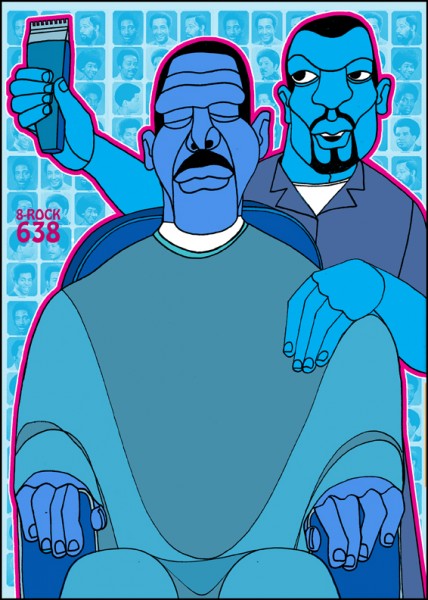A few years ago I came across a book called Where Men Hide. It was written by James B. Twitchell, and it was something between a homage to and a social history of the spaces and institutions in the U.S. that have served as gathering places for men. Twitchell argues that these gathering places have also served not only as places for enjoying the camaraderie of other men, but also as retreats from the scrutiny of women and children and the demands of fatherhood, work, and romantic partnership; and he believes that these spaces are on the decline.
Among those spaces whose gradual disappearance Twitchell explores are fraternal organizations, VFW halls, hunting lodges, and barbershops. I know relatively little about the first three types of spaces, and I am willing to take Twitchell’s analysis of their role at face value. I am, however, fairly well-versed on the subject of barbershops and, in my experience, the barbershop business is doing just fine.
I have worn a short ‘fro since 1986, and I have been going to barbershops for most of the last 27 years. From what I can see, the Black barbershop–as a business, a gathering place, and as beloved cultural icon– is thriving. And I’m not just referring to Black barbershops in Oakland. I have found this to be true in pretty much every place I’ve lived or visited that has at least a critical mass of Black people. What do I mean by critical mass? Well, the one place I lived that had no Black barbershop at all was Eugene, Oregon which, at the time, had a Black population of less than one percent (in a city of about 120,000 people). Providence, Rhode Island, where I studied and worked from 1984 to 1990, had the second lowest Black population, percentage-wise, of anywhere I’ve lived, with about 3% (at the time). This was in a metropolitan area of around a million residents. Back then, however, there were at least two Black barbershops on the city’s East Side alone (which was not, incidentally, the part of the city in which most Black people lived). So, I suppose that the critical mass necessary for a city to have at least one Black barbershop would have to be somewhere between the 1200 Black folks who lived in Eugene and the nearly 30,000 who lived in Providence and surrounding cities.
The point of all this geeking out over population statistics is to say that, then as now, in heavily Black cities like Oakland as well as in areas with slimmer Black populations like Providence, barbers who cater to people of African descent seem to be doing a brisk business. Their establishments are gathering places for the community and the barber’s themselves are the holders, creators, and transmitters of Black aesthetics.
I really like Twitchell’s book, but his conclusion that the barbershop is on the decline is one of many indications that his title is misleading.* Instead of Where Men Hide, it should probably be something along the lines of Where White Men Hide; and there’s nothing really wrong with that. Not every book has to be about Black people. The problem is when the writer fails to notice or even acknowledge the exclusionary nature of his text.
Ajuan Mance
*Another clue that his is a race-specific text is Twitchell’s long discussion of model railroading, a hobby whose minority participants have expressed concern about the lack of diversity (although a small number its Black participants hold prominent positions in model railroading organizations).
